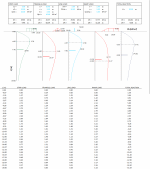SURCHARGE_LOADS_TIPS2.xlsx

Description
A surcharge load is an additional retaining wall load superimposed onto the earth pressure force to yield the total lateral force.
SURCHARGE LOADS:
STRIPS LOADS
TRIANGULAR LOADS
LINE LOADS
RAMP LOADS
The TOTAL REACTIONS are also calculated.
You may also be interested to see this other download relating to surcharge loads.
Calculation Reference
Geotechnics
Soil Mechanics
Craig's Soil Mechanics
Retaining wall design
In the context of retaining wall design and Craig's Soil Mechanics, surcharge loads refer to the additional pressures exerted on the soil behind the retaining wall due to various load types. These loads are essential in designing a retaining wall to ensure it can withstand the applied forces and maintain stability. The different surcharge loads are:
-
Strip loads: These loads are applied uniformly over a linear area (e.g., the load from a strip footing). They cause a uniform pressure distribution and are crucial in calculating the lateral earth pressure on the retaining wall.
-
Triangular loads: These loads vary linearly over a specified distance, creating a triangular pressure distribution. They often result from sloping ground surfaces or irregular load distributions and must be considered in retaining wall design to prevent failure.
-
Line loads: Line loads represent concentrated forces acting along a line (e.g., the load from a retaining wall or a wheel load from a vehicle). They lead to a non-uniform pressure distribution and are critical in the design process to ensure retaining wall stability.
-
Uniform loads: Uniform loads are distributed evenly over the entire area behind the retaining wall. They result in a constant pressure distribution and can be caused by soil weight, hydrostatic pressure, or other uniform loads. These loads are essential for retaining wall design as they can increase lateral earth pressure and affect wall stability.
-
Ramp loads: Ramp loads are loads that increase or decrease linearly over a specified distance, resulting in a trapezoidal pressure distribution. They can occur due to changes in ground elevation, variable load distributions, or other factors. Like other surcharge loads, ramp loads need to be considered in retaining wall design to ensure the structure's stability and safety.
Calculation Preview
Full download access to any calculation is available to users with a paid or awarded subscription (XLC Pro).
Subscriptions are free to contributors to the site, alternatively they can be purchased.
Click here for information on subscriptions.



